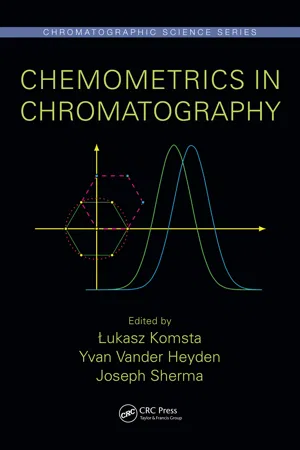
This is a test
- 506 pages
- English
- ePUB (mobile friendly)
- Available on iOS & Android
eBook - ePub
Chemometrics in Chromatography
Book details
Book preview
Table of contents
Citations
About This Book
Chemometrics uses advanced mathematical and statistical algorithms to provide maximum chemical information by analyzing chemical data, and obtain knowledge of chemical systems. Chemometrics significantly extends the possibilities of chromatography and with the technological advances of the personal computer and continuous development of open-source software, many laboratories are interested in incorporating chemometrics into their chromatographic methods. This book is an up-to-date reference that presents the most important information about each area of chemometrics used in chromatography, demonstrating its effective use when applied to a chromatographic separation.
Frequently asked questions
At the moment all of our mobile-responsive ePub books are available to download via the app. Most of our PDFs are also available to download and we're working on making the final remaining ones downloadable now. Learn more here.
Both plans give you full access to the library and all of Perlego’s features. The only differences are the price and subscription period: With the annual plan you’ll save around 30% compared to 12 months on the monthly plan.
We are an online textbook subscription service, where you can get access to an entire online library for less than the price of a single book per month. With over 1 million books across 1000+ topics, we’ve got you covered! Learn more here.
Look out for the read-aloud symbol on your next book to see if you can listen to it. The read-aloud tool reads text aloud for you, highlighting the text as it is being read. You can pause it, speed it up and slow it down. Learn more here.
Yes, you can access Chemometrics in Chromatography by Łukasz Komsta, Yvan Vander Heyden, Joseph Sherma in PDF and/or ePUB format, as well as other popular books in Ciencias físicas & Química analítica. We have over one million books available in our catalogue for you to explore.
Information
Section III
Data Preprocessing and Unsupervised Analysis
7
Introduction to Multivariate Data Treatment
CONTENTS
7.1Basic Considerations
7.2Basic Operations on Matrices
7.2.1Matrix Inversion
7.2.2Matrix Pseudoinverse
7.3The Geometrical Point of View
7.3.1Dissimilarity Measures
7.3.2Spanning and Subspaces
7.3.3Matrix Rank
7.3.4Orthogonal Complement
7.4Projection onto a Subspace
7.4.1Centering as a Projection
7.4.2Model and Orthogonal Distances
7.5Matrix Factorizations
7.5.1Rotation as Factorization
7.5.2Singular Value Decomposition
7.5.3Eigenvalue Decomposition
7.6Concluding Remarks
7.1Basic Considerations
Chromatographic experiments often derive a multivariate dataset, which can (and should) be presented and analyzed as a matrix. A matrix is a rectangular array of numbers, and it can be easily presented as a table. A fragment of a spreadsheet, filled with numbers, is a good example of a matrix. If one considers the peak areas of 5 compounds and 30 samples are measured, then, for instance, a 30 × 5 table (matrix) can be built.
Multivariate datasets are obtained for objects (e.g., samples) having some properties (e.g., peak areas), and for each object all properties are measured. In chemometrics, the standard convention to arrange data in a matrix is that matrix rows correspond to objects and matrix columns to properties. Such multivariate dataset is a two-way array with consistency inside the rows and columns, in the sense that a value in ith row and jth column must represent the jth property of ith object.
In general, the choice of what is considered as object is arbitrary and depends on the context of the data analysis. Any matrix can be transposed by changing the rows and columns. Then everything reverses—the rows become the properties and the columns become the objects. To understand this concept, several examples are given in the following:
- 50 compounds were chromatographed in 30 chromatographic systems and the retention times were measured. The matrix can have 50 rows and 30 columns. Each cell will contain the retention time of the corresponding compound in the corresponding system. By transposing the above matrix, a reverse interpretation can be obtained—30 chromatographic systems are considered as objects, each characterized by 50 properties (the retention times of 50 compounds), that is, by the retention profile of the compounds. This type of matrix is, for instance, created in column characterization or classification.
- 50 samples were chromatographed in one of the above systems. The areas of 20 main peaks were recorded. One can arrange the results as a matrix with 50 rows and 20 columns, filled with peak areas. Each sample (object) is characterized by 20 properties, representing the chemical composition of a sample. Hence the chemical profile of a sample is then considered.
- 50 samples were ch...
Table of contents
- Cover
- Halftitle Page
- Series Page
- Title Page
- Copyright Page
- Dedication Page
- Contents
- Preface
- Contributors
- SECTION I Method Development and Optimization
- SECTION II Univariate Analysis
- SECTION III Data Preprocessing and Unsupervised Analysis
- SECTION IV Classification, Discrimination, and Calibration
- SECTION V Retention Modeling
- SECTION VI Application Overviews
- SECTION VII Miscellaneous
- Index